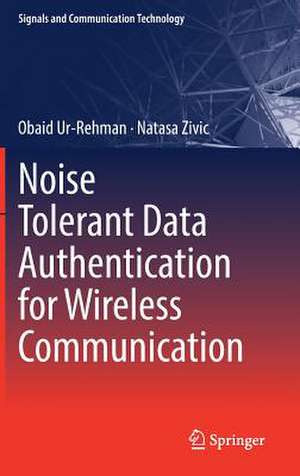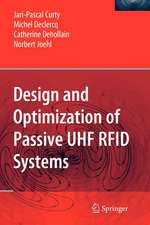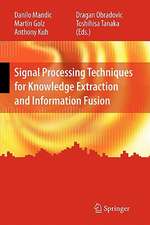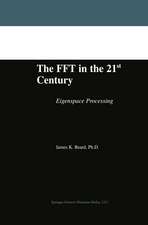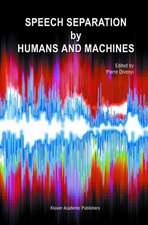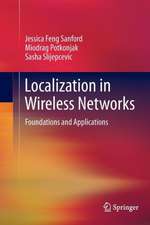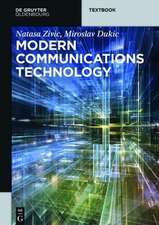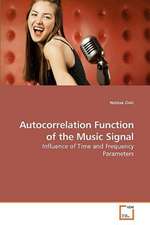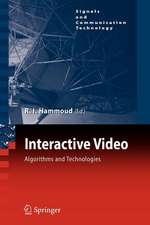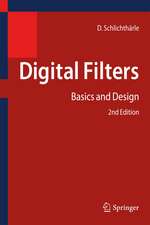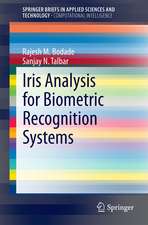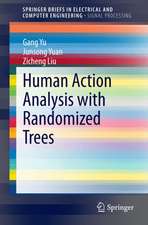Noise Tolerant Data Authentication for Wireless Communication: Signals and Communication Technology
Autor Obaid Ur Rehman, Natasa Zivicen Limba Engleză Hardback – 10 apr 2018
- Provides a discussion of data (particularly image) authentication methods in the presence of noise experienced in wireless communication;
- Presents a new class of soft authentication methods, instead of the standard hard authentication methods, used to tolerate minor changes in image data;
- Features authentication methods based on the usage of authentication tags as well as digital watermarks.
| Toate formatele și edițiile | Preț | Express |
|---|---|---|
| Paperback (1) | 409.43 lei 6-8 săpt. | |
| Springer International Publishing – 21 dec 2018 | 409.43 lei 6-8 săpt. | |
| Hardback (1) | 416.54 lei 6-8 săpt. | |
| Springer International Publishing – 10 apr 2018 | 416.54 lei 6-8 săpt. |
Din seria Signals and Communication Technology
- 18%
 Preț: 952.89 lei
Preț: 952.89 lei - 18%
 Preț: 1559.80 lei
Preț: 1559.80 lei - 17%
 Preț: 361.80 lei
Preț: 361.80 lei - 18%
 Preț: 811.61 lei
Preț: 811.61 lei - 15%
 Preț: 585.26 lei
Preț: 585.26 lei - 18%
 Preț: 727.97 lei
Preț: 727.97 lei - 15%
 Preț: 585.90 lei
Preț: 585.90 lei -
 Preț: 393.35 lei
Preț: 393.35 lei - 20%
 Preț: 1002.73 lei
Preț: 1002.73 lei - 15%
 Preț: 641.71 lei
Preț: 641.71 lei - 20%
 Preț: 338.92 lei
Preț: 338.92 lei - 18%
 Preț: 1579.66 lei
Preț: 1579.66 lei - 18%
 Preț: 896.08 lei
Preț: 896.08 lei - 18%
 Preț: 847.11 lei
Preț: 847.11 lei - 18%
 Preț: 1234.77 lei
Preț: 1234.77 lei - 18%
 Preț: 905.54 lei
Preț: 905.54 lei - 15%
 Preț: 646.43 lei
Preț: 646.43 lei - 20%
 Preț: 662.48 lei
Preț: 662.48 lei - 15%
 Preț: 641.20 lei
Preț: 641.20 lei - 18%
 Preț: 1847.84 lei
Preț: 1847.84 lei - 18%
 Preț: 946.24 lei
Preț: 946.24 lei - 18%
 Preț: 1241.10 lei
Preț: 1241.10 lei - 20%
 Preț: 649.43 lei
Preț: 649.43 lei - 20%
 Preț: 993.28 lei
Preț: 993.28 lei - 18%
 Preț: 940.57 lei
Preț: 940.57 lei - 18%
 Preț: 1389.30 lei
Preț: 1389.30 lei - 20%
 Preț: 1003.50 lei
Preț: 1003.50 lei - 18%
 Preț: 953.52 lei
Preț: 953.52 lei - 20%
 Preț: 1001.16 lei
Preț: 1001.16 lei - 18%
 Preț: 1415.36 lei
Preț: 1415.36 lei - 15%
 Preț: 653.33 lei
Preț: 653.33 lei - 15%
 Preț: 645.60 lei
Preț: 645.60 lei - 15%
 Preț: 637.28 lei
Preț: 637.28 lei - 18%
 Preț: 948.79 lei
Preț: 948.79 lei - 18%
 Preț: 945.62 lei
Preț: 945.62 lei - 18%
 Preț: 836.36 lei
Preț: 836.36 lei - 18%
 Preț: 1225.46 lei
Preț: 1225.46 lei - 15%
 Preț: 635.01 lei
Preț: 635.01 lei - 15%
 Preț: 639.25 lei
Preț: 639.25 lei - 15%
 Preț: 646.30 lei
Preț: 646.30 lei - 15%
 Preț: 639.25 lei
Preț: 639.25 lei - 15%
 Preț: 712.36 lei
Preț: 712.36 lei - 20%
 Preț: 1006.12 lei
Preț: 1006.12 lei - 18%
 Preț: 970.56 lei
Preț: 970.56 lei
Preț: 416.54 lei
Nou
Puncte Express: 625
Preț estimativ în valută:
79.71€ • 86.56$ • 66.96£
79.71€ • 86.56$ • 66.96£
Carte tipărită la comandă
Livrare economică 22 aprilie-06 mai
Preluare comenzi: 021 569.72.76
Specificații
ISBN-13: 9783319789415
ISBN-10: 3319789414
Pagini: 85
Ilustrații: XI, 73 p. 36 illus., 10 illus. in color.
Dimensiuni: 155 x 235 mm
Greutate: 0.3 kg
Ediția:1st ed. 2018
Editura: Springer International Publishing
Colecția Springer
Seria Signals and Communication Technology
Locul publicării:Cham, Switzerland
ISBN-10: 3319789414
Pagini: 85
Ilustrații: XI, 73 p. 36 illus., 10 illus. in color.
Dimensiuni: 155 x 235 mm
Greutate: 0.3 kg
Ediția:1st ed. 2018
Editura: Springer International Publishing
Colecția Springer
Seria Signals and Communication Technology
Locul publicării:Cham, Switzerland
Cuprins
Chapter1: Introduction and the Need for Noise Tolerant Data Authentication.- Chapter2: Wireless Communications.- Chapter3: Noise Tolerant Data Authentication Mechanisms.- Chapter4: Digital Watermarking Techniques.- Chapter5: Dual Watermarking with Error Correction.- Chapter6: Enhanced Decoding based on Authenticating the Region of Interests.- Chapter7: Authentication with Block Level Error Localization.
Notă biografică
Obaid Ur-Rehman is a post-doctoral fellow at the chair for data communications systems of the University of Siegen in Germany. He received his M.Sc. degree in 2004 in Computer Engineering from the Faculty of Electrical Engineering at the University of Engineering and Technology, Taxila, Pakistan and his Dr.-Ing. degree in 2012 from the Chair for Data Communications Systems at the University of Siegen, Germany. During his doctoral research he worked on soft decoding techniques for error correcting codes and their applications in various fields, such as data and image authentication in the presence of noise and over wireless communication channels. Dr.-Ing. Ur-Rehman currently works as a scientific researcher at the Chair for Data Communications Systems at the University of Siegen, Germany. He is involved in various research projects funded by industry and the European Union. He has more than 10 years of industrial and academic experience. He is actively participating in conferencesand has given tutorials at various international conferences. He also serves as a reviewer for various international journals and has authored more than 30 scientific research publications in international journals and conferences.
Natasa Zivic is an Associated Professor and a Private Docent at the University of Siegen. She works as a lecturer at the University of Siegen since 2007, teaching Basics of Communication Techniques, Digital Communications Technologies I and Digital Communications Technologies II. She received Dipl.- Ing. degree (1999) and a Magister degree (2002) from the Faculty of Electrical Engineering at the University of Belgrade, Serbia. She started her research at the Chair for Data Communications Systems at the University of Siegen, Germany in October 2004. She received Dr.-Ing. Degree from the University Siegen, Faculty for Electrical and Computer Engineering in 2007 and continued her work as a lecturer and as a postdoctoral candidate. Shedefended her Postdoctoral Degree (Habilitation) in area of Electrical Engineering and Telecommunications from the University Siegen in 2012. Her actual areas of interest are connection between cryptography and standard communication techniques like channel coding, and applying of cryptography in communications, especially in noisy environments. She published about 100 journal and conference papers, 2 monographs and 3 patents (2 in Germany and 1 in USA). She works as a member of the German national body in ISO and as a project editor of security standards. She served as a TPC member and an organizer of several IEEE conferences/workshops and as a technical reviewer of several IEEE and other journals. She is a member of IEEE and IEEE Communication Society.
Textul de pe ultima copertă
This book provides insight into the challenges in providing data authentication over wireless communication channels. The authors posit that established standard authentication mechanisms – for wired devices – are not sufficient to authenticate data, such as voice, images, and video over wireless channels. The authors propose new mechanisms based on the so-called soft authentication algorithms, which tolerate some legitimate modifications in the data that they protect. The authors explain that the goal of these algorithms is that they are tolerant to changes in the content but are still able to identify the forgeries. The authors go on to describe how an additional advantage of the soft authentication algorithms is the ability to identify the locations of the modifications and correct them if possible. The authors show how to achieve this by protecting the data features with the help of error correcting codes. The correction methods are typically based on watermarking, as the authors discuss in the book.
- Provides a discussion of data (particularly image) authentication methods in the presence of noise experienced in wireless communication;
- Presents a new class of soft authentication methods, instead of the standard hard authentication methods, used to tolerate minor changes in image data;
- Features authentication methods based on the usage of authentication tags as well as digital watermarks.
Caracteristici
Provides a discussion of data (particularly image) authentication methods in the presence of noise experienced in wireless communication Presents a new class of soft authentication methods, instead of the standard hard authentication methods, used to tolerate minor changes in image data Features authentication methods based on the usage of authentication tags as well as digital watermarks
